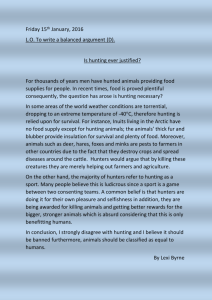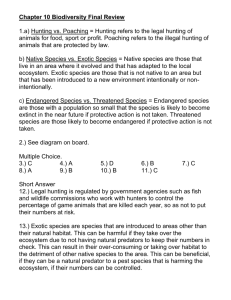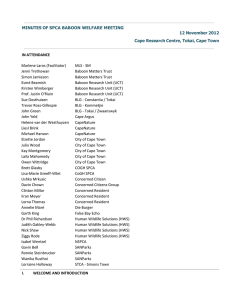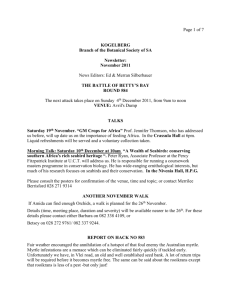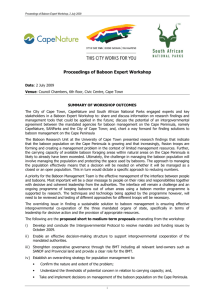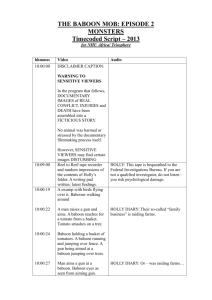In terms of the Constitution of South Africa, citizens of the
advertisement
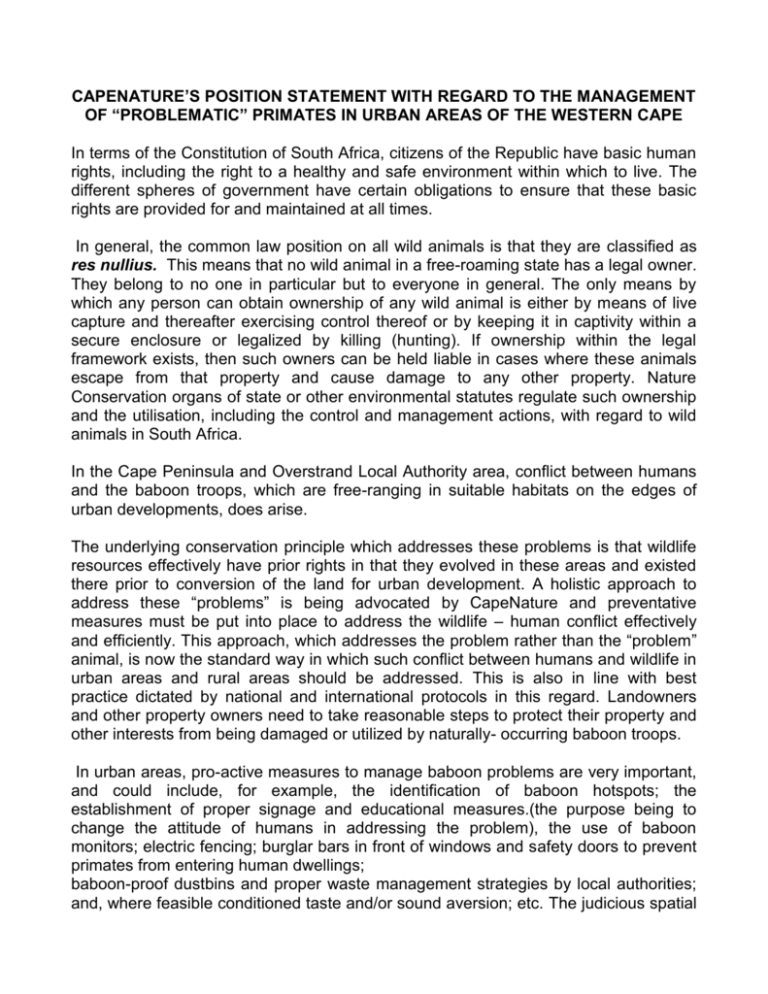
CAPENATURE’S POSITION STATEMENT WITH REGARD TO THE MANAGEMENT OF “PROBLEMATIC” PRIMATES IN URBAN AREAS OF THE WESTERN CAPE In terms of the Constitution of South Africa, citizens of the Republic have basic human rights, including the right to a healthy and safe environment within which to live. The different spheres of government have certain obligations to ensure that these basic rights are provided for and maintained at all times. In general, the common law position on all wild animals is that they are classified as res nullius. This means that no wild animal in a free-roaming state has a legal owner. They belong to no one in particular but to everyone in general. The only means by which any person can obtain ownership of any wild animal is either by means of live capture and thereafter exercising control thereof or by keeping it in captivity within a secure enclosure or legalized by killing (hunting). If ownership within the legal framework exists, then such owners can be held liable in cases where these animals escape from that property and cause damage to any other property. Nature Conservation organs of state or other environmental statutes regulate such ownership and the utilisation, including the control and management actions, with regard to wild animals in South Africa. In the Cape Peninsula and Overstrand Local Authority area, conflict between humans and the baboon troops, which are free-ranging in suitable habitats on the edges of urban developments, does arise. The underlying conservation principle which addresses these problems is that wildlife resources effectively have prior rights in that they evolved in these areas and existed there prior to conversion of the land for urban development. A holistic approach to address these “problems” is being advocated by CapeNature and preventative measures must be put into place to address the wildlife – human conflict effectively and efficiently. This approach, which addresses the problem rather than the “problem” animal, is now the standard way in which such conflict between humans and wildlife in urban areas and rural areas should be addressed. This is also in line with best practice dictated by national and international protocols in this regard. Landowners and other property owners need to take reasonable steps to protect their property and other interests from being damaged or utilized by naturally- occurring baboon troops. In urban areas, pro-active measures to manage baboon problems are very important, and could include, for example, the identification of baboon hotspots; the establishment of proper signage and educational measures.(the purpose being to change the attitude of humans in addressing the problem), the use of baboon monitors; electric fencing; burglar bars in front of windows and safety doors to prevent primates from entering human dwellings; baboon-proof dustbins and proper waste management strategies by local authorities; and, where feasible conditioned taste and/or sound aversion; etc. The judicious spatial planning of urban growth and development is obviously also of strategic importance in the holistic management of the human/nature interface. However, CapeNature recognizes that occasionally, despite taking such preventative measures, certain individual animals are repeat offenders which manage to circumvent the protective measures taken. Animals which learn to overcome these measures, are usually those generally considered to have relatively high levels of intelligence, such as primates. When satisfactory evidence has been provided that despite taking the appropriate precautionary measures to prevent or minimize such damage/loss, only then is it reasonable to take further measures to attempt to solve the problem, such as cage-trapping or other appropriate management actions. The onus, however, remains on the landowner/property owner to demonstrate that he/she applied the preventative measures in a reasonable and responsible manner. Under such circumstances the animals which are caught can potentially be considered for further management intervention, including translocation, euthanasia, or utilization for other purposes. Legal Status of Baboons The hunting of wild animals is regulated in terms of the Nature and Environmental Conservation Ordinance 19 of 1974 as amended, as well as the Hunting Proclamation that is promulgated annually. In terms of the Nature and Environmental Conservation Ordinance, animals are protected if they are listed in Schedule 2 to the Ordinance or in Appendix II of CITES. Baboons are not listed in Schedule 2, but are listed in Appendix II of CITES . Therefore they are protected animals in the Western Cape. This term “protected” has been much misunderstood and needs some unpacking. In this context, “protected” means that persons may only hunt a protected animal if they comply with the following conditions: i. Hold a valid hunting licence; ii. Are hunting on their own property or have the explicit written consent of the landowner on whose property the hunt occurs; and iii. Are hunting in terms of the Hunting Proclamation as issued annually by WCNCB. There are two categories of geographic area excluded from the above dispensation. It does not apply in any proclaimed National Park nor does the Hunting Proclamation permit hunting in the Cape Peninsula Protected Natural Environment (CPPNE). This latter exclusion came about at the specific request of interested parties in the early 1980’s after an entire, troublesome troop of baboons at Kommetjie had been removed (shot). The season for hunting baboons in the current proclamation is all year round. This means that outside of the National Park in the Peninsula but inside the CPPNE, baboons can only be hunted subject to a special permit being issued by CapeNature and with the written consent of the landowner and the relevant Local Authority. This seems to have been a very effective measure in preventing people shooting baboons in the Peninsula although it has placed no constraint on the activities of SANParks. It must also be mentioned that CapeNature calls for public comment annually before revising the Hunting Proclamation. No case has ever been made for an amendment of the dispensation as it affects the Peninsula. The primary responsibility of CapeNature regarding the management of human-wildlife conflict should be seen as providing the legal framework (including compliance management) as well as an advisory service. It is therefore important to differentiate between the physical control of wild animals causing damage in local authority areas and the legislative responsibilities of CapeNature. In this regard, CapeNature is responsible for dealing with any transgression of the ordinance or provincial regulations regarding the hunting, captivity, sale, breeding, theft and transport of wild animals within a municipal area. CapeNature is also responsible for inspections and the necessary permit administration within the Local Authority area. Although the operational management of human-animal conflict falls outside the mandate of CapeNature (this is the responsibility of the land-owner or manager), it was decided, as an interim arrangement, to establish a baboon monitoring project in the highly problematic areas of Hermanus and the Cape Peninsula as part of a poverty relief programme (R3,5 million was secured by CapeNature for this purpose---the project ended in June 2008.) The main objective with this interim and urgent intervention was to ensure that a strategic and successful baboon management model is developed in areas where high levels of conflict are experienced. The relevant (local and Conservation) authorities, in partnership with the relevant communities must ensure that this model becomes sustainable and that they take the necessary responsibility for the management of the baboon-human conflict in their areas of jurisdiction.



